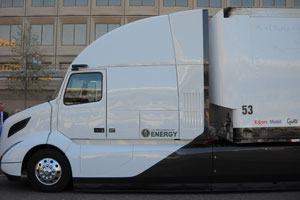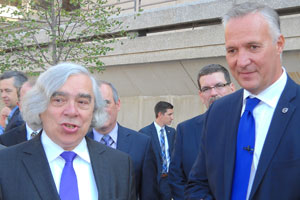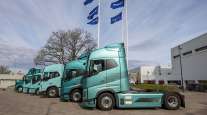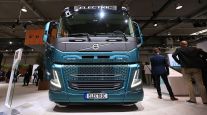Volvo Shows Off SuperTruck Entry to Energy Secretary Ernest Moniz

 Lorrie Grant/Transport Topics
Lorrie Grant/Transport Topics On the same day that VTNA showed off its results from SuperTruck Phase 1, the original equipment manufacturer also said it has been selected to receive another $20 million for Phase 2 of the Department of Energy research program. DOE spends the money, which must be matched dollar-for-dollar by OEMs, to develop heavy-duty trucks that are more fuel efficient, thereby conserving energy and reducing diesel emissions.
“I’m very excited about this SuperTruck initiative. . . It’s important for the United States, but this is drawing international attention as well,” said Moniz, who has been secretary since May 2013.
 Moniz, Nyberg by Lorrie Grant/Transport Topics
Moniz, Nyberg by Lorrie Grant/Transport Topics Moniz, who knew that 81% of U.S. freight, as measured by revenue, travels on trucks, said doubling fuel efficiency “is a big deal.”
He said the most complex systems, such as waste-heat recovery, “are going to take longer to be part of the commercial offerings. But we want to see these technologies entering, not as, like, one SuperTruck from any of the vendors, but as a set of technology lessons incorporated with time as the costs come down.”
VTNA President Göran Nyberg led Moniz on the inspection tour, along with several of the OEM's engineers.
“This is a knowledge accelerator,” Nyberg said of SuperTruck at a press briefing prior to the DOE event. He said the research produced a 6.5% increase in fuel efficiency through powertrain optimization and an additional 3.5% gain through better aerodynamics.
Using a 2009 Volvo as a baseline, miles per gallon rose to 12, on average, from 7 mpg. By changing some steel components to aluminum and introducing carbon-fiber materials, the Volvo SuperTruck dropped 3,200 pounds in net weight, helping to increase fuel efficiency — ton-miles traveled per gallon of fuel used — by 88% over the 2009 baseline.
While SuperTruck 1 focused on linehaul applications, Phase 2 will offer more for regional applications, VTNA Senior Vice President Susan Alt said.
 Lorrie Grant/Transport Topics
Lorrie Grant/Transport Topics The DOE grant to Volvo, which must be funded by Congress to become official, calls for the company to increase fuel efficiency by using alternative engine designs and lightweight tractor-trailers. Volvo must match the $20 million it gets from DOE.
The OEM will work with truckload carrier Knight Transportation and grocery chain Wegman’s Food Markets to test new systems for SuperTruck 2.
The research program coincides with federal regulation of greenhouse-gas emissions of heavy- and medium-duty trucks by the Environmental Protection Agency and the National Highway Traffic Safety Administration.
Nyberg said VTNA’s 2017 powertrains, which comply with Phase 1 of GHG rules, include several components that were developed as part of SuperTruck 1, specifically, wave pistons that minimize unburned fuel; a common-rail, fuel-injection system; and turbo compounding, an elementary form of waste-heat recovery.
In August, EPA and NHTSA released their final version of Phase 2 of GHG regulation, a rule that will tighten emission standards on trucks in 2021, 2024 and 2027. More technology developed in SuperTruck 1 and 2 will help the manufacturer meet those standards, Nyberg said, but he declined to specify which innovations are closest to introduction.
“There’s enough meat on this,” Nyberg said of the research results.




